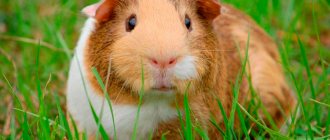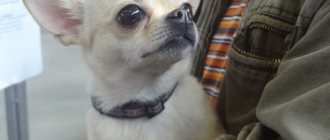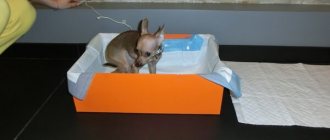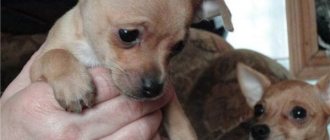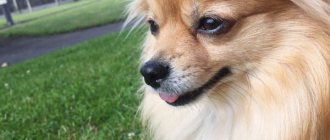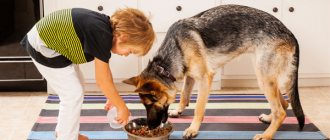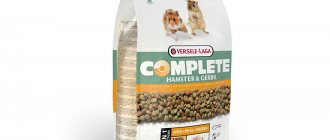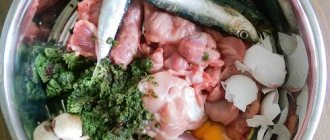Chihuahua dogs are popular due to their small stature, cute appearance and friendly character. The size of a pet greatly simplifies caring for it, however, due to the characteristics of the body, such animals need proper and balanced nutrition. It is very important to carefully monitor that nothing unnecessary gets into your pet’s diet, because some foods can lead to serious consequences. At the same time, it is necessary to provide the dog with enough trace elements and proteins so that it can live a long and happy life.
General principles of feeding Chihuahuas
The Chihuahua is an excellent companion that makes the life of its owners more colorful and fun. The quality of life of a dwarf dog directly depends on the products included in its diet. To ensure your pet develops well and enjoys good health, follow a few rules:
- Always have your daily meal in the same place;
- Serve food at room temperature (not hot or frozen);
- Do not feed your dog food intended for people;
- remove the bowl after eating;
- do not feed your Chihuahua after 19:00;
- provide constant access to clean water;
- When feeding using the traditional method, serve only freshly prepared food.
FAQ
What to feed if you have an allergy?
There are all kinds of lines of hypoallergenic food, the most optimal and simple option. If you don’t want to give up natural food, you’ll have to work hard to find out what exactly your Chihuahua is allergic to.
Potentially hypoallergenic products are:
- turkey and rabbit meat;
- zucchini and cauliflower;
- rice.
Very often, an allergy can be triggered by a sudden transition from one food to another, due to a rapid change in proteins.
What to feed a Chihuahua with pancreatitis?
Pancreatitis is inflammation of the pancreas.
For pancreatitis, a diet low in fat and low in fiber is indicated, as it is very difficult to digest. From ready-made food, for example, the GASTRO INTESTINAL line has been developed.
What to feed a Chihuahua after poisoning?
First of all, a short-term fasting diet is necessary. After a day of fasting, you can try rice water. If you have an appetite, you can give boiled chicken breast, cottage cheese, but to a minimum - in small portions.
What to feed a Chihuahua if its teeth fall out?
If your dog has toothache, you should consult a doctor; perhaps a simple brushing will solve all your problems. But if the problem does start and the teeth fall out, then you need to make it easier for the dog to chew.
If the food is dry, then grind the granules and you can soak them in water (not broth!). When feeding natural food, you will have to give up hard-to-chew foods and chop the meat into smaller pieces.
Can Chihuahuas eat baby food?
Not recommended. If you give your dog such a “treat” once a month, there will be no harm. But you cannot feed on a regular basis. Although the products in baby food are all natural and no preservatives are used, we should not forget that the human and dog bodies are fundamentally different.
Rules for feeding puppies
It is very important for Chihuahua puppy owners to adhere to the following rules:
- do not include prohibited foods on your dog’s menu;
- do not mix different types of food in one bowl;
- create a diet that includes easily digestible foods.
When a puppy is taken away from its mother and siblings, it becomes stressed. In order not to aggravate the pet’s depressive state, in the first two weeks it is necessary to feed it in the same way as the breeders did.
Problems
It's also worth considering some of the nutritional issues your pet may be experiencing.
Doesn't eat well
Let's highlight several reasons why Chihuahuas don't eat well.:
- the dog overeats and is fed very often;
- the dog does not like the diet;
- forced to eat;
- she experiences pain, there are pathologies in the body;
- uncomfortable conditions.
If you have already identified the cause, then you should move on to solving the problem:
- Don't force your Chihuahua to eat. Don't add extra food to her bowl if there is already another one in there. Give your dog the food he likes.
- Stick to a routine. Feed an adult dog 2 times a day.
- Provide a comfortable environment for the dog so that it is not disturbed from eating and drinking.
- Contact your veterinarian for help.
Refuses food
Reasons why a dog is hungry:
- She is stressed, perhaps upset about something.
- Unusual conditions, for example, different food, a new bowl, an unpleasant smell from the bowl, people.
- The dog became seriously ill, had a fever and pain.
What to do:
- We create comfortable conditions for your pet.
- We change the bowl and eat.
- We measure the temperature and look for the source of pain. To do this, we probe the dog’s body with our fingers. With her reaction she will be able to show the place where it hurts.
Feeding Chihuahua puppies by age
Representatives of the dwarf breed grow up very quickly - by 12 months they become full-fledged adults. In the first year of life, it is very important for puppies to receive a sufficient amount of vitamins and microelements for the proper formation of the skeleton and general development of the body. Within three weeks after birth, babies receive everything they need along with mother's milk, after which other foods can be gradually introduced into their diet. Let's take a closer look at what food can be added to the menu of Chihuahua puppies, depending on their age.
- 3-4 weeks. Three weeks after birth, the dogs are not yet weaned from their mother, but they are already starting to feed them low-fat boiled meat and cottage cheese. After another week, babies are allowed to give boiled cereals such as rice, buckwheat and semolina. When puppies are one month old, light soups based on chicken or fish broth are introduced into the diet. When a little Chihuahua has been weaned from its mother, you can include goat's milk with egg yolk in its menu.
- 2-3 months. At this age, puppies accept fermented milk products such as kefir, fermented baked milk and yogurt well. The diet is supplemented with porridge dishes with meat in a 50/50 percentage of ingredients. The daily food intake at three months is 30 grams, at 4 months – 45 grams.
- 4-5 months. At this age, the Chihuahua’s body stops absorbing fresh milk, so it is completely excluded from the menu. If you decide to continue feeding your baby natural food, the portions must be increased to 60 grams per day. You can start adding vegetables to traditional dishes. If you plan to feed your pet dry food in the future, it's time to start accustoming your dog to this diet. It is best to give your baby canned food or dry puppy food, slightly soaked in warm water.
- 6-8 months. Over a period of six months to 8 months, the daily volume of feed is increased from 60 to 90 grams. The majority of portions (at least 50%) should be lean meat. You can add apples and bananas, crushed to a pulp, to your diet.
- 9-12 months. At this age, young Chihuahuas can be completely switched to an adult diet, but it is important to control the amount of calories in food. Up to 10 months, puppies continue to actively grow, so their portions should contain about 100 kcal. Older dogs are no longer growing as actively, and excess calories can lead to excess weight. For this reason, the daily diet of a young dog aged 10 to 12 months should contain no more than 40 kcal.
Allowed and healthy products
Naturally, the list is huge, I don’t see the point in listing all the products, but I’ll touch on the main ones that you can pamper your pet with, and are available in almost every home:
- Vegetables:
carrots, cabbage, pumpkin, cucumber, tomato. - Fruits and berries:
green apple, melon, cranberry, watermelon, banana, raspberry, strawberry, wild strawberry, papaya (without peel and seeds), blueberries, gooseberries, dried apricots, currants, pear, tangerines, oranges. - Cereals:
buckwheat, rice, millet. Barley, rolled oats, oatmeal and semolina are practically not absorbed by the body, and can provoke intestinal volvulus. The richest porridge in minerals and easily digestible by the Chihuahua’s digestive system is buckwheat! - Dairy products:
cottage cheese, unleavened hard cheese, kefir, sour cream.
Fresh berries, fruits, vegetables and dairy products are served as treats in reasonable quantities and not often.
Cereals and vegetables are often used as a side dish when feeding natural foods. From vegetables, you can prepare a stew with pieces of lean (lean) meat, seasoned with sour cream or a small amount of olive oil. From cereals - porridge with meat or sea fish fillet. Vegetables can also be given raw as a light snack between meals. The optimal percentage of meat product in relation to the side dish: 60% meat versus 40% side dish. Salting and seasoning is prohibited!
Vary the menu if you feed your Chihuahua natural food to achieve maximum balance in the diet. It may be necessary to add specialized vitamin supplements (complexes) to food, but without recommendations and consultation with a veterinarian, independent initiative is inappropriate.
Daily diet for puppies
Dishes for a young Chihuahua should contain the following elements: proteins of plant or animal origin, carbohydrates and fats. If the owners have chosen a traditional diet as a permanent feeding method, the dog must be given additional vitamins. Supplements are introduced into the menu only in strict dosages, because their excess can lead to a deterioration in the pet’s condition. Be sure to discuss the need for vitamin supplements with your veterinarian.
The number of meals per day depends on your Chihuahua puppy's activity, weight, and metabolism. The standard diet according to the pet’s age is as follows:
- up to 3 weeks – newborns are fed by the mother;
- from 3 weeks to 2 months – puppies are still fed by their mother, but they should have additional food available 24/7;
- from 2 to 3 months – meals 5-6 times a day;
- from 3 to 6 months – feeding 3-4 times a day;
- from six months to 12 months – meals 2-3 times a day.
As soon as the pet turns one year old, it needs to be fed no more than twice a day. In this case, between the first and second meals, the dog can be treated with a small amount of treats.
Pros and cons of natural food
In addition to a varied menu and the absence of harmful preservatives, flavorings, flavor enhancers and dyes, a natural diet has a number of other advantages:
- the owner of the Chihuahua can independently choose products, assessing their quality and freshness;
- all micro- and macroelements of natural origin necessary for the proper development of a dog;
- natural products are easier to digest;
- If an allergic reaction to a certain product occurs, it can be replaced with another without changing the main diet.
In addition, natural nutrition allows you to save significantly if you purchase seasonal fruits and vegetables and alternate beef with chicken.
However, this diet also has its disadvantages.:
- You cannot cook several days in advance - stale food loses its beneficial components and can lead to poisoning;
- it is necessary to give the dog additional vitamins and minerals;
- creating a balanced menu will require time and certain knowledge;
- For people accustomed to traveling with a dog, natural feeding poses a problem and inconvenience.
Feeding a dog with natural products is convenient for less busy people who have the opportunity and desire to cook for their pet every day.
Authorized Products
A balanced diet necessary for the proper development of a Chihuahua should consist of 60% protein of animal origin, 30% of cereals, vegetables and fruits and 10% of fermented milk products.
The pet menu should definitely include:
- boiled and chopped lean meat - veal, beef, turkey, chicken;
- buckwheat, oatmeal and millet porridge;
- steamed or raw vegetables and fruits;
- low-fat fermented milk products - cottage cheese, yogurt, yogurt, kefir, sour cream, cheese.
Also, the natural diet should contain:
- boiled sea fish, rich in vitamins A, D, B – once a week;
- boiled eggs for shiny coat - every 3-4 days;
- offal as an alternative to meat, but a maximum of 2 times a week, otherwise vomiting and diarrhea are possible;
- crackers or bread to develop chewing muscles and clean teeth;
- vegetable oils as an additional source of fats.
You will also need to take an additional vitamin-mineral complex.
List of things that are strictly contraindicated
| Product | Consequences of use |
| Beans | Provoke flatulence |
| Mushrooms | Put a strain on the liver and can lead to poisoning |
| Milk | In adults, the product is not absorbed and causes diarrhea. |
| Onion | Leads to anemia |
| Nuts | It contains a lot of phosphorus, which causes stones to form in the bladder and bones to become brittle |
| Freshwater fish | Contains many bones, infested with parasites |
| Rice | Promotes constipation |
| Chocolate and other sweets | Their use puts a strain on the pancreas and is fraught with the appearance of excess weight, problems with stool, oral diseases, and the development of type 2 diabetes |
| Bones, especially tubular bones | May cause gastrointestinal injuries |
| bell pepper | Causes gastritis |
| Fatty meats, particularly pork | Often a source of helminths, its consumption leads to obesity |
| Pickles, smoked meats | Increases the load on the kidneys and liver and increases blood pressure |
In addition, Chihuahuas should not be fed raisins, grapes, radishes, cabbage, canned food, and the consumption of tea, coffee, and alcoholic beverages is prohibited.
Feeding your dog prohibited foods leads to problems with the gastrointestinal tract, teeth and liver..
Diet for an adult dog
The diet of an adult dog can be of two types: dry and traditional. The first method is to feed the pet dry food and canned food - such a diet already includes all trace elements and vitamins, and also does not take much time from the owner to prepare. The second method involves preparing natural dishes for the animal, takes more time and requires supplementing the menu with vitamins. The advantage of a traditional diet is that your pet will definitely not get tired of the same type of food, like dry food.
The following natural products can be given to an adult Chihuahua dog:
- raw chicken, beef and other types of lean meat;
- offal (liver, kidneys, heart);
- lean fish;
- boiled cereals (rice, buckwheat, semolina);
- dairy products;
- vegetables;
- vegetable oil (as part of dishes).
Toxic, harmful and dangerous products
It is very important to never feed your Chihuahua the following foods for objective reasons and veterinary indications:
- chocolate, candy, cookies and caffeinated products;
- onions and peppers (including bell peppers);
- salt and sugar, including products containing them;
- legumes: peas, beans, peanuts, lentils and others;
- pasta;
- alcoholic and carbonated drinks;
- bones (especially tubular ones);
- seeds and seeds of any fruit;
- raisins and prunes;
- grape;
- avocado;
- pomegranate;
- cherry;
- mushrooms;
- broccoli;
- nutmeg and macadamia.
!
Milk is not a dangerous or toxic product, but it can cause a runny nose and stomach upset. It is advisable to pamper with boiled milk, cooled to room temperature.
What can you give besides dry food?
During adolescence, when the Chihuahua's baby teeth fall out, bone-strengthening supplements can be included in the diet - fish oil, brewer's yeast and bone meal. There are also special dietary recommendations for male and female Chihuahuas.
For males. Male Chihuahuas need a lot of protein in order to be able to reproduce. To do this, the menu for male pets must include chicken eggs, fish, vegetable oil and vitamin A. Lack of calcium and lack of mineral trace elements in food can lead to the animal developing paralysis.
For bitches. The menu for girls of the dwarf dog breed must be adjusted during pregnancy and feeding of the puppies. To be able to bear full-fledged offspring, the animal needs additional calories and vitamins. Bitches often turn their noses up when they get bored of a certain food. If such a situation arises, it is necessary to reduce the calorie content of portions, reduce the number of treats and walk the dog in the fresh air more often.
Vitamins and microelements in the Chihuahua diet
Throughout not only growing up, but throughout life, it is necessary to add vitamin and mineral supplements to the diet. You don’t even have to invent anything, there are specially designed complexes for small breeds:
- multivitamins 8 in 1 Excel Small Breed for small breed dogs (the most recommended supplement);
- Happy Dog Haar Special Forte food supplement for nourishing the skin and coat of dogs;
- food supplement 8 in1 Excel calcium/Glucosamine.
At home, you can give crushed eggshells and brewer's yeast.
Traditional dishes for adults
A natural diet is definitely a great way to keep your pet healthy and happy. It is important to remember that the traditional menu must include vitamins and mineral supplements.
Example menu for one day:
- first meal – boiled cereal with vegetables and lean fish;
- second meal - boiled vegetables and raw meat.
Example of a weekly diet for a Chihuahua:
- Monday – raw rabbit meat, boiled rice, fermented baked milk and boiled cauliflower;
- Tuesday – boiled hake, boiled egg, millet porridge and apple puree;
- Wednesday – boiled buckwheat and pollock, yogurt, chopped raw carrots;
- Thursday - beef, semolina porridge, banana puree and boiled pumpkin;
- Friday – chopped offal, stewed carrots and applesauce;
- Saturday – chopped kidneys, fermented baked milk, boiled rice, vegetable oil and boiled zucchini;
- Sunday – raw chicken, oatmeal, cottage cheese and peach puree.
An adult pet is fed twice a day, so the daily food intake is divided into two meals. The break between the first and second feeding should be about 12 hours. Dinner should be served no later than 2-3 hours before bedtime.
Mini food features
If you get a mini Chihuahua, then be prepared to feed your pet strictly on a schedule. By not following the schedule, you increase the risk of poisoning, intestinal blockage, loss of strength and other troubles in your pet’s body.
The diet of mini Chihuahuas is almost no different from the diet of regular Chihuahuas. Their diet also consists of cereals, meat, vegetables, and sometimes you can add finely chopped greens. Do not indulge your pet with sweets , because this breed has a tendency to become obese.
If your pet does not finish all the food from the bowl, and he is not sick or experiencing any problems, then you should reduce the amount of food served to him.
If there is a need to revise the type of food, then you need to replace some foods with others very carefully, gradually.
Using our recommendations, you can easily determine what kind of food you will use. By choosing an individual diet for your pet, you are taking care of his health. Remember that a healthy dog is a happy dog !
Helpful tips for creating a traditional menu for an adult dog
When choosing a traditional feeding method, adhere to the following rules:
- do not make minced meat products - it is better to serve meat and offal chopped into pieces;
- Grind hard vegetables on a coarse grater;
- do not serve boiled bones – raw ones are better accepted by the dog’s body;
- include some fermented milk products in your menu every day;
- Boil porridge in meat or vegetable broth;
- Cook semolina porridge in low-fat milk.
Foods that can be given to toy dogs:
- cereals - oatmeal, rice and buckwheat, cooked in broth in a ratio of 1:3, as well as semolina porridge in milk or water;
- fish – capelin, hake, cod and boiled sea bass;
- vegetables - zucchini, carrots and pumpkin, boiled or stewed with the addition of vegetable oil.
What not to feed
We figured out what natural products the diet of miniature dogs consists of. And now I will explain what foods should not be given to pets and why:
- Table leftovers contain spices, fats that have been heat-treated, smoked foods, and table salt. Such products cause digestive upsets or allergic reactions.
- The tubular bones of an adult bird split lengthwise and injure the intestines.
- Grass legumes – soybeans or peas contain anti-nutrients.
- By-products cause digestive disorders in small dogs.
- Milk: contains lactose; dogs older than 4 months do not produce the enzyme to break down milk sugar.
- Confectionery products, sweets, and yeast baked bread cause fermentation processes and increase blood glucose levels. The body removes excess sugars by converting them into fats. Sweets are broken down in the mouth cavity, fermented into organic acids that destroy tooth enamel.
- Boiled potatoes contain easily digestible starch, which is converted into fat.
- Raw river fish contains the enzyme Thiaminase, which destroys vitamin B1, causing skin lesions and joint diseases. Raw sea fish contains helminth larvae and trimethylamine oxide, which binds iron and causes anemia.
- Raw eggs contain Avidin, which destroys vitamin H. The coat becomes brittle and dull.
I will answer questions in the comments.
Chihuahua's favorite food
Despite the fact that representatives of the dwarf breed are ready at any moment to eat everything that falls from the table to the floor, they have their own favorite treats. Such treats include meat, cheese, dried fruits and rye cookies. Many pets also enjoy eating bones and lean fish. Daily food intake for an adult dog
The daily standard for Chihuahuas aged 1-7 years is from 35 to 45 kcal per kilogram of weight, depending on the animal's lifestyle and metabolism. For dogs over eight years old, the daily food intake is about 30 kcal per 1 kg of weight. Animals over 10 years old are already considered elderly - their metabolic process slows down, so they are fed only once a day.
During the day, you can periodically treat your pet with treats, for example, give a piece of apple, a bone or rye cookies.
Food selection
You need to decide on the type of food in advance, and for this you need to know the pros and cons of each type of feeding.
Straight
A diet made up of natural foods.
Pros: You are confident in the quality of the products you use. You can adjust the diet depending on the characteristics and preferences of your Chihuahua.
Cons: requires certain knowledge to correctly create a diet. A lot of time is spent on preparing and purchasing the necessary products.
Commercial feed
Dry plus wet food or canned food.
Pros: fast and convenient, does not require any investment of your time. Balanced, no need to calculate anything, the manufacturers did everything for you. Profitable.
Disadvantages: the products used to make feed are not of the highest quality. You may not know the exact composition. Contains preservatives.
Diet menu
Chihuahuas are prone to obesity, which leads to poor health and decreased activity of their four-legged friend. If you become overweight, be sure to contact your veterinarian to create a diet menu. A diet for a plump dog looks something like this:
- the total amount of daily food is reduced by 15-20%;
- treats are replaced with vegetables;
- reduce the calorie content of dishes;
- cereals are cooked only in vegetable broth;
- change the usual dry food to low-calorie varieties.
As you grow older
Puppies feed on their mother's milk until they are approximately 2 months old. But sometimes up to 4 months. It is recommended to completely wean offspring from mother's milk at 3-4 months. Further feeding of the Chihuahua depends on your choice and the dog’s taste preferences. There are 2 ways of feeding: natural and ready-made food.
There are dogs that can consume both types, and there are individuals for whom one type is suitable: either natural or prepared food. Some people experience diarrhea, diarrhea, and stomach problems from natural food, while others have a similar reaction to ready-made food. Just watch your four-legged friend. See what he likes to eat more. Does the food cause intestinal upsets and digestive problems? If yes, then this is a signal that the chosen feeding method is not suitable for you and needs to be replaced.
Do not mix natural and commercial food!
Diet for pets prone to allergies
Common allergens include chicken, eggs, seafood and red vegetables. The cause of problems is not only traditional dishes, but also dry food that contains the listed components. If signs of an allergic reaction appear in pets eating according to the traditional method, they are transferred to a diet consisting of turkey and rabbit meat, rice, zucchini and cabbage. If your four-legged friend is allergic to dry food, you need to replace it with a hypoallergenic variety.
Refusal to eat: possible reasons
Dogs often refuse to eat. This happens for various reasons. It is very important to distinguish manipulation and cunning inherent in small dogs from a situation requiring medical intervention.
Refusal of food often occurs due to the owner’s habit of pampering their pet with treats from the table. The animal becomes capricious, demanding, constantly begs for food from the owner, and gets used to forbidden food.
Sometimes dogs arrange fasting days for themselves. Often pets refuse food due to heat, hormonal changes during estrus or pregnancy. Males lose their appetite during the mating period or when they feel the close presence of an estrous individual of the opposite sex. The reason for refusal to eat may be stress associated with a change of place of residence or separation from the owner.
But if your little pet becomes lethargic, then develops a fever, or, conversely, experiences hypothermia; he is feverish; he developed discharge from the nose, eyes, ears, repeated vomiting, and bleeding; feces have acquired a putrid, fetid odor; a strong rumbling appeared in the tummy, and the stool became frequent and liquid, the problem is serious. There is no need to hope that everything will come to its senses on its own. In such cases, urgent intervention by a veterinarian is necessary.
The well-being of a pet largely depends on how attentive the owner is to him. Proper care and good nutrition are the basis for the health and excellent mood of your Chihuahua. Regardless of what food you feed your pet, the products must be fresh and of the best quality. Love and care will make your dog’s life long and happy, allowing him to remain active and good-natured until his last days.
Don't forget about nutritional supplements and vitamins
However, if you are wondering what to feed a 2-month-old Chihuahua puppy, even with a balanced diet, you should not forget about vitamins and healthy nutritional supplements.
First of all, the problem of calcium and iodine deficiency should be solved. The first solution is simple - one crushed calcium gluconate tablet is added to the diet. To obtain iodine, it is best to use seaweed - boiled or soaked in boiling water. You can add a drop of vitamin D to the food - it is sold in pharmacies and is inexpensive.
Finally, to strengthen the immune system and support health, you can give a quarter spoon of honey diluted in warm (but not hot!) water.
Choosing the ideal ready-made food
If you feed your Chihuahua with ready-made food, then you need to select super-premium food that contains all the useful substances. The amount that should be given to the dog is stated in the instructions for the food printed on the packaging. The table shows the required amount of food taking into account the age, weight and size of the dog.
There are two types of ready-made food: dry and wet in the form of canned food. They are made from high quality meat products. Dry food is available in granular form. They can be given either dry or soaked. To do this, the granules need to be moistened with boiled water and given to the dog when cooled to room temperature.
The dog must eat the food prepared in this way within 10 minutes; it cannot be given again. Dry food can remain in the bowl all the time without spoiling. The advantage of dry food is that it helps remove tartar, which is a problem for Chihuahuas.
Canned food can be fed neat or mixed with herbal supplements or added to dry food. Wet food should not be left, it must be put in the refrigerator so that it does not spoil. Feed should be given at room temperature.
Modern ready-made super premium food is balanced and contains all the necessary nutrients. You don’t have to worry about your pet, as he will receive everything his body needs. When choosing food, you need to consider what dogs it is intended for. There are dietary foods that are prescribed for dogs with health problems.
Below are some of the best super premium foods:
- Nutra Gold;
- Belcando;
- Bosch;
- 1st Choice;
- Almo Nature;
- Hill's;
- Purina;
- Orijen.
There is a large selection of different companies that produce ready-made animal feed. If you care about your pets, then you should purchase food only from trusted super premium manufacturers.
When purchasing food for a Chihuahua, it is better to consult a breeder or veterinarian. It is important to decide on the manufacturer and buy food only from this company. Therefore, it must be widespread enough so that it can always be purchased. If the food is replaced, this may negatively affect the health of the pet.
Recommendations for creating an ideal diet
Adult and young Chihuahuas should be fed according to a schedule, puppies more often, adults twice a day: morning and evening. It is contraindicated to feed your pet too late, before bedtime. For an older dog, feeding once a day will be enough, but feeding a Chihuahua three times a day is also possible, it depends on the animal itself.
To prevent your pet from being picky about food, you need to make sure that he does not know any other food other than what is in his bowl. That is, he should not be given any other tasty food. If a specific type of super premium industrial feed is selected, it should not be changed.
A Chihuahua's daily diet should contain:
- proteins;
- fats;
- minerals;
- carbohydrates;
- vitamins.
Proteins are found in meat products, cheese, fish, and cottage cheese. Carbohydrates are in cereals. Since Chihuahua meat is given low-fat, fats can be replenished with vegetable oil. Vitamins and minerals are contained to some extent in vegetables and fruits, but when feeding them naturally, it is better to buy a vitamin and mineral complex.
The best option for feeding a Chihuahua would be a ready-made, balanced super-premium food containing all the substances necessary for the dog’s body. If you take good care of your Chihuahua and feed it properly, then the dog will be cheerful and active.
Chihuahua dogs should eat well, but not overeat, as they are often prone to obesity. Fasting is a great danger for dogs of toy breeds, as they are prone to hypoglycemia.
How to protect yourself from obesity?
This issue should be taken very seriously when caring for your animal. Chihuahua is a breed with a tendency to be overweight. To prevent the occurrence of this disease, follow the general rules.
- These dogs love to eat, and some of them cannot control their satiety. Free access to food is unacceptable.
- Feeding is carried out strictly according to the clock. To avoid malnutrition and oversaturation, do not break the schedule and stick to the established regime.
- Do not feed your dog from the communal table.
Older dogs are more likely to suffer from obesity, and this is quite natural, since many physiological changes occur at this time. Older dogs are less active and their metabolic rate is significantly reduced. It is very sad when obesity appears in young dogs due to overeating and mistakes of their owners.
Most owners do not realize that obesity entails a whole list of concomitant diseases: arthritis, tracheal collapse, inflammation of the ligaments and tenosynovitis, diabetes, diseases of the gastrointestinal tract, heart and kidneys, musculoskeletal system, respiratory tract and dislocations of the kneecaps. These diseases pose a great threat to such a small and fragile dog breed.
How to create a diet?
To ensure a complete and balanced diet, follow the percentage ratio: 36% of all food is meat.
- 16% of all food is dairy products.
- 10% of all food is fish.
- 14% of all food is cereals.
- 15% of all food is vegetables.
- 9% of all food is fruit.
Sample daily menu for an adult dog
- Breakfast. 8.00 - 10.00. Boiled meat (or offal) or steamed trout with zucchini.
- Dinner. 15.00 - 16.00. Kefir, cottage cheese or 2 quail eggs.
- Dinner. 19.00 - 20.00. Buckwheat porridge with carrots, half an apple.
Make sure that your four-legged friend's diet alternates protein foods (fish, meat, eggs, cheese) with cereals, vegetables and fruits every day. So, for example, when choosing meat for the morning, you should provide your dog with vegetables, fruits and grains for lunch and dinner. The next day, choose fish with vegetables for breakfast, and for lunch and dinner, give dairy products, fruits, and porridge. Remember, fruits and vegetables, cereals should be included in every day, and meat, fish and dairy products are the basis of nutrition. Cereals are carbohydrates; too frequent consumption can lead to metabolic disorders.
How to properly feed pregnant and lactating dogs
In order for a small dog to bear and give birth to healthy offspring, a pregnant Chihuahua needs to be fed a special diet. Dogs that receive dry food are switched to special brands for pregnant women: Royal Canin Mini Starter Mother & Babydog, Bozita super premium Puppy & Junior WHEAT FREE 25/13, etc.
Naturally fed dogs are given more foods containing calcium: apples, cottage cheese and cauliflower. Just before childbirth, the level of protein in the diet is reduced, and meat and fish are excluded 7-8 days before birth.
After giving birth, dogs are also not given meat for the first days. They feed him cottage cheese, give him calcium supplements and fermented milk products. From the second week they feed him stewed meat with vegetables, give him porridge, and boiled egg yolk. If the bitch is not allergic to milk, you can give her goat's milk.
Important! Be sure to give special vitamin and mineral complexes during pregnancy and lactation.
Prohibited Products
Please pay special attention that these foods should not be given to Chihuahuas! For them it is poison!
- Carbonated drinks.
- Alcohol.
- Caffeine.
- Hop.
- Pork.
- Sausage.
- Canned food.
- Tubular bones.
- Legumes.
- Plum pits.
- Apricot kernels.
- Peach pits.
- Walnut.
- Nutmeg.
- Macadamia.
- Avocado.
- Raisin.
- Grape.
- Pepper.
- Sugar, any sweets, candies, chocolate.
- Salt, salty.
- Spicy.
- Smoked.
- Roast.
- Pickled.
- Puddings, cakes, baked desserts.
- Mushrooms.
- Condiments, herbs, spices, mustard.
- Onions, onion powder.
- Potato tops.
- Rhubarb leaves.
- Tomato tops.
- Yeast mixture, flour, cookies, buns, bread.
- Pasta.
- Ice cream.

